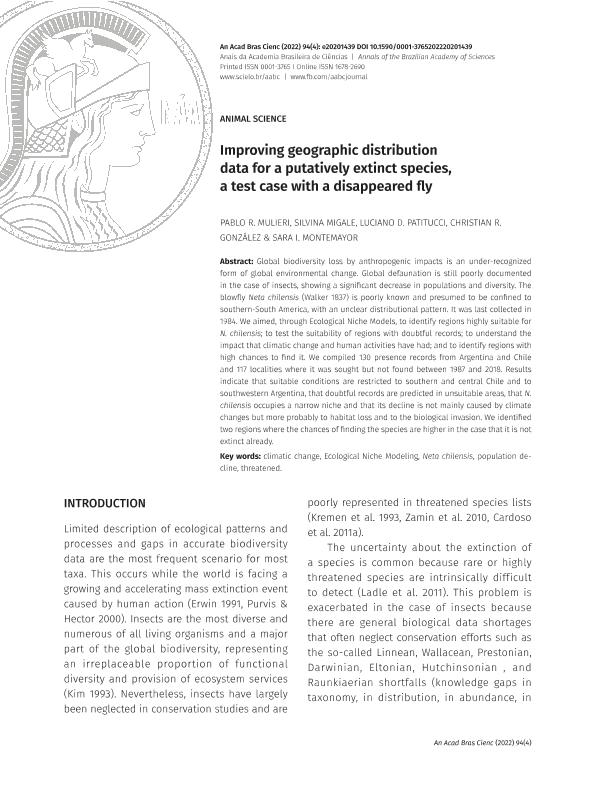Artículo
Improving geographic distribution data for a putatively extinct species, a test case with a disappeared fly
Mulieri, Pablo Ricardo ; Migale, Silvina; Patitucci, Luciano Damián
; Migale, Silvina; Patitucci, Luciano Damián ; González, Christian R.; Montemayor Borsinger, Sara Itzel
; González, Christian R.; Montemayor Borsinger, Sara Itzel
 ; Migale, Silvina; Patitucci, Luciano Damián
; Migale, Silvina; Patitucci, Luciano Damián ; González, Christian R.; Montemayor Borsinger, Sara Itzel
; González, Christian R.; Montemayor Borsinger, Sara Itzel
Fecha de publicación:
07/2022
Editorial:
Academia Brasileira de Ciencias
Revista:
Anais da Academia Brasileira de Ciencias
ISSN:
0001-3765
e-ISSN:
1678-2690
Idioma:
Inglés
Tipo de recurso:
Artículo publicado
Clasificación temática:
Resumen
Global biodiversity loss by anthropogenic impacts is an under-recognized form of global environmental change. Global defaunation is still poorly documented in the case of insects, showing a significant decrease in populations and diversity. The blowfly Neta chilensis (Walker 1837) is poorly known and presumed to be confined to southern-South America, with an unclear distributional pattern. It was last collected in 1984. We aimed, through Ecological Niche Models, to identify regions highly suitable for N. chilensis; to test the suitability of regions with doubtful records; to understand the impact that climatic change and human activities have had; and to identify regions with high chances to find it. We compiled 130 presence records from Argentina and Chile and 117 localities where it was sought but not found between 1987 and 2018. Results indicate that suitable conditions are restricted to southern and central Chile and to southwestern Argentina, that doubtful records are predicted in unsuitable areas, that N. chilensis occupies a narrow niche and that its decline is not mainly caused by climate changes but more probably to habitat loss and to the biological invasion. We identified two regions where the chances of finding the species are higher in the case that it is not extinct already.
Palabras clave:
Climatic change
,
Neta chilensis
,
Ecological Niche Modeling
,
Threatened
Archivos asociados
Licencia
Identificadores
Colecciones
Articulos(CCT - LA PLATA)
Articulos de CTRO.CIENTIFICO TECNOL.CONICET - LA PLATA
Articulos de CTRO.CIENTIFICO TECNOL.CONICET - LA PLATA
Citación
Mulieri, Pablo Ricardo; Migale, Silvina; Patitucci, Luciano Damián; González, Christian R.; Montemayor Borsinger, Sara Itzel; Improving geographic distribution data for a putatively extinct species, a test case with a disappeared fly; Academia Brasileira de Ciencias; Anais da Academia Brasileira de Ciencias; 94; 4; 7-2022; 1-17
Compartir
Altmétricas



